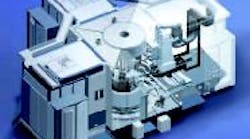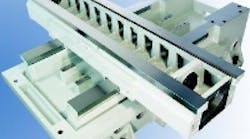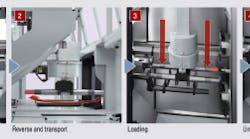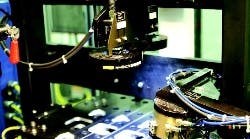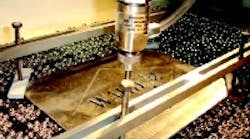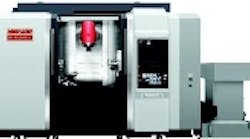A LiCON Liflex flexible machining system uses three sixspindle LTC modules. Workpieces are mounted to fixtures carried by a rotary transfer in the center of the system.
LiCON's four-spindle Quadspeed provides axis travels of 15.75 15.75 X 24.80 in. with positioning accuracy of 0.0004 in. and repeatability of 0.0002 in.
A new machining module promises to nearly eliminate toolchange times for certain highvolume applications. LiCON's Linear Tool Changer (LTC) uses a cluster of four or six driven, tooled spindles, eliminating conventional toolchangers. The only "toolchange" time is the 0.8 sec it takes to position another spindle on the fixtured workpiece.
The module is based on the premise that most production applications use less than 20 tools, include 24 or fewer operations, and require cutting cycle times of 3 sec or less. The unit is more efficient when arranged in a series (transfer line with several stations) as opposed to parallel production (machining centers grouped together for production). That's because a parallel-production system, while highly flexible, requires more toolchanges to complete a part.
The LTC four or six-spindle machining modules tackle aluminum, cast iron, and steel. A single 15-kW motor drives all spindles. Spindle center distance is just 6.3 in. Because all spindles are always rotating, operating speed is achieved much more quickly than with conventional machining centers, slashing acc/dec times. To accelerate the spindle by 1,000 rpm requires only 0.1 sec. Conventional machining centers would use an average of an additional 1.5 sec in acc/dec time from and to 0 rpm.
Rapid traverse for the LTC is 197 ft/min. It delivers spindle speeds up to 10,000 rpm (optional 15,000 rpm). The four-spindle LTC, Quadspeed, provides axis travels of 15.75 15.75 24.80 in. with positioning accuracy of 0.0004 in. and repeatability of 0.0002 in. Providing a tool-clearance advance of 6.3 in., each spindle moves hydraulically into a taper for high rigidity. Spindle nose adapters receive an HSK 63 toolholder. Maximum tool diameter is approximately 5 in., with an 11-lb weight capacity. Tools are fixed in the spindles of the LTC with no ATC or turret toolchanges. This arrangement, according to the company, ensures improved process stability and tool control.
Appropriate applications of the LTC include cylindrical parts that require several different operations, such as center drill, drill, and chamfer in several locations. Because toolchange time is reduced to 0.8 sec, the sequential operations can be done more quickly than is possible with a machining center. And a fourth and fifth axis for part fixtures allows all sides of the part to be presented to the 3-axis LTC modules, avoiding a second clamping and letting the part be completely machined. End machining a crankshaft is a typical application where total cycle time could be reduced by 8 to 10 sec/part.
